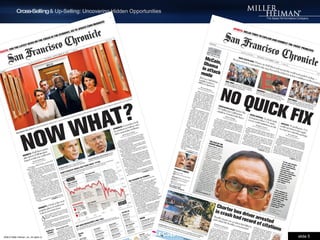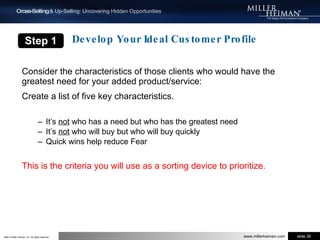Cross-Selling & Up-Selling with Miller Heiman
- 1. Cross-Selling & Up-Selling:Uncovering Hidden OpportunitiesRich Blakeman - Sales Vice President, Miller HeimanSAN FRANCISCOCHAMBER OF COMMERCEWhere smart business starts
- 4. How does it look to you?This year I will achieve my sales quota.? %? % Others World Class
- 6. How did it look last October?This year I will achieve my sales quota.83%48% Others World Class
- 8. Who we areMiller Heiman – The Sales Performance CompanyMiller Heiman helps companies and individuals that compete for high-value business-to-business sales develop strategies, processes and skills to consistently win business – especially when the sales process is complex and the marketplace demanding. We have been in business for more than 30 years. Over this time we’ve evolved into the world’s largest sales performance consulting and training firm and the preeminent thought leaders in the space. Our reach: Over 1,250,000 alumni Over 10,000 client engagements Programs translated in 17 languages Operating in over 35 countries
- 9. 2009 Miller Heiman Sales Best Practices StudyAnnual study reveal trends, issues, opportunities in a complex selling environmentBenchmarks year-over-year trendsSurvey conducted in October 2008Sixth year of study3,900+ sales professionals participated in current study21,000 participants to date
- 11. Cross-Selling DefinedCross-selling (verb) Expanding the number and quality of relationships between key people in the buying organization and the selling organization, and/orMaking additional relevant solutions available to the buying organization (e.g., new products).
- 12. Up-Selling DefinedUp-selling (verb) Converting an initial order into a more profitable order. Typically manifested by the customer's commitment to: (1) additional units of the seller's solution – or – (2) a premium version of the seller's solution. This doesn't mean selling one's customers something they don't need; it does mean selling one's customers more of something that they do need.
- 13. Timing for Effective Cross-Selling & Up-SellingBuying ProcessStatusQuoNeed toChangeRecognizedDefineProblemEvaluateOptionsSelectBestImplementAssessValue
- 14. Timing for Effective Cross-Selling & Up-SellingBuying ProcessStatusQuoNeed toChangeRecognizedDefineProblemEvaluateOptionsSelectBestImplementAssessValueUp-SellingCross-Selling
- 15. Sales Leadership Challenges TodayIncrease average deal sizeEffectively introduce new products/services to the marketGrow sales without significant increases in resourcesDifferentiation through increased value
- 16. Do your customers understand the full breadth of your capabilities?
- 17. Only 34 percent of top-performing sales organizations report that their customers understand the full breadth of their capabilities, and only 22 percentof all other organizations make the same claim.2008 Miller Heiman Sales Best Practices Study
- 18. Existing Client/CustomerNew Client/CustomerProven Product/Service13New Product/Service241 - 4 = Most to Least PredictablePredictability Analysis Model
- 19. Our sales force is very effective at selling new products / services.74%37% Others World Class
- 20. The Number One Reason People Don’t Cross-Sell Up-Sell
- 21. The Number One Reason People Don’t Cross-Sell Up-SellFEAR
- 22. Fear of Cross Selling & Up-SellingFear of losing is the number one reason salespeople do not cross-sell and up-sell more often.
- 23. 92%91%43%37%OthersWorld ClassOthersWorld ClassOur organization regularly collaborates across departments to manage strategic accounts.Sales and Marketing are aligned in what our customers want and need.
- 25. 4 Steps to More Effective Cross-Selling & Up-SellingDevelop Your Ideal Customer ProfileMap the New Buying ProcessUnderstand the ConceptDefine Unique StrengthsStep 1Step 2Step 3Step 4
- 26. Develop Your Ideal Customer ProfileStep 1Consider the characteristics of those clients who would have the greatest need for your added product/service:Create a list of five key characteristics.It’s not who has a need but who has the greatest needIt’s not who will buy but who will buy quicklyQuick wins help reduce FearThis is the criteria you will use as a sorting device to prioritize.
- 27. Example: Ideal Customer ProfileFast sales head-count growthHigher than expected sales force turnoverClient has shared their concern as to whether they have the right peopleNew VP of Sales in placeCompanies in the midst of a merger or acquisitionSize of sales forceWhich current clients match your Ideal Customer Profile?
- 29. Step 2Map the New Buying ProcessWho will help you gather information?Do you know this person – do you need to develop this person?Who will make final decision to buy?Do you know this person – do you need additional info?
- 30. Develop Your CoachRole: acts as a guide for cross-selling and up-sellingProactively develop at least oneA Coach can provide and interpret information about:Validity of this Opportunity Other Buying Influences Focus: your success with this proposalAsks: “How can we make this happen?”
- 31. Recognize where the decision will get made.Who holds the budgetary/financial responsibilityWho’s ultimately responsible for the success/failure when purchasing your product/serviceCalling at the right level is criticalTop-performing sales organizations include client executives in the sales cycle1:52 percent more likely to gain access to key decision makers57 percent more likely to systematically identify the issues of key individuals56 percent more likely to have relationships and dialog at the highest executive levels with strategic accountsMust be selling at the Economic Buying Influence level!1 - Source: 2009 Miller Heiman Sales Best Practice Study
- 32. Step 3Understand the ConceptFinding the optimal solutionEvery customer has a solution image or ConceptCustomers buy what they think your solution will enable them to accomplishThe Customer’s Concept evolves during the buying processThe sales professional needs to understand the Customer’s ConceptCustomers have Concepts; companies do not
- 33. Customer’s ConceptAccomplish somethingFix somethingAvoid somethingCreate a Valid Business ReasonProvide a compelling reason for this person to invest time with you
- 34. Is bigger better? Why?What is Unique and better about the larger solution? What are your Strengths?How are your Strengths important to your customer?Define Unique StrengthsStep 4
- 35. DifferentiationProducts, services, or solutions must be differentiated before the customer makes a decision to buy, or that decision may be based on price aloneCustomers do not buy products, services, or solutions per se; they buy what they think or feel the products, services, or solutions will accomplish for themYour Customers must see a link between your product, service, or solution and their ConceptSo What? Prove It!
- 36. Review of the 4 Steps to EffectiveCross-Selling & Up-SellingDevelop Your Ideal Customer ProfileMap the New Buying ProcessUnderstand the ConceptDefine Unique StrengthsStep 1Step 2Step 3Step 4




































